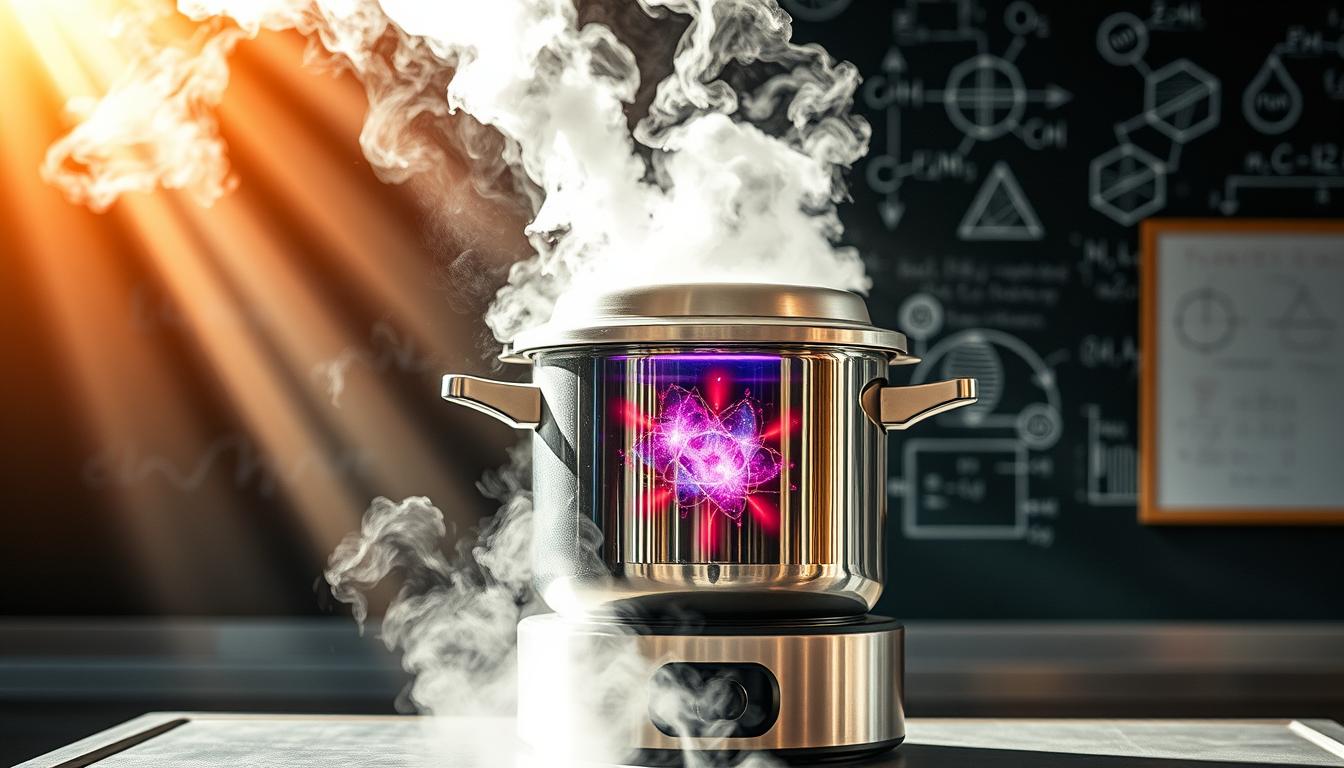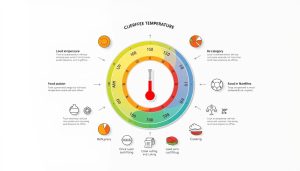At 15 psi, water boils at 250°F instead of 212°F – a temperature jump that turns tough meat tender in 45 minutes rather than 3 hours. This kitchen magic happens through precise manipulation of steam and atmospheric forces inside a sealed vessel.
French inventor Denis Papin pioneered this concept in 1679 with his “steam digester,” proving trapped vapor accelerates cooking. Today’s devices use the same principle: increasing pressure raises water’s boiling point, allowing food to absorb heat faster while retaining moisture.
You’ll explore how modern cookers apply gas laws to optimize energy use. When volume stays constant (V), rising temperature (T) directly increases pressure (P) – expressed as PV=nRT. This relationship lets rice cook perfectly in 8 minutes instead of 20.
Safety valves and precision seals maintain ideal conditions for nutrient retention. Unlike slow simmering, pressurized environments prevent vitamin loss while deepening flavors through rapid starch gelatinization and protein breakdown.
Key Takeaways
- Sealed cookers reach 250°F by trapping steam at 15 psi pressure
- Higher temperatures reduce cooking times by up to 70%
- 17th-century steam digestion experiments inspired modern designs
- Gas law physics governs pressure-temperature relationships
- Enhanced moisture retention preserves food texture and nutrients
- Safety mechanisms prevent over-pressurization risks
Uncovering the Science Behind Pressure Cooking
Your kitchen becomes a laboratory when steam transforms ordinary water into a supercharged cooking agent. Sealed environments manipulate basic physical principles to achieve results impossible in open-air pots.

Heat, Steam, and Boiling Point Dynamics
Applying heat to water in a locked chamber creates pressurized vapor that behaves differently than regular steam. At 15 psi, liquid reaches 250°F instead of boiling at 212°F – this elevated boiling point lets foods absorb energy faster. You’re essentially cooking with superheated moisture that penetrates ingredients more effectively.
Convection currents circulate this dense steam uniformly. Tough fibers in meats break down quicker while grains like rice achieve perfect texture in minutes. The system works because trapped vapor conducts thermal energy 25x better than dry air.
Pressure Release and Safety Mechanisms
Modern devices use dual safety systems to prevent accidents. A primary valve automatically vents excess steam when internal pressure exceeds safe limits. Secondary locks engage if the main regulator fails, creating redundant protection.
You’ll find three critical components in quality cookers: weighted pressure controls, silicone gaskets, and interlocking lids. These work together to maintain optimal conditions while preventing sudden depressurization. Quick-release buttons let you safely halt cooking processes when timing matters.
The Physics of Pressure Cooking: Principles and Applications
Harnessing steam’s power unlocks faster, more efficient cooking methods. When you seal a pot, vapor builds to create an environment where fundamental physics principles reshape meal preparation.

How Increased Pressure Elevates Boiling Points
Every pound per square inch of trapped steam raises water’s boiling temperature. At 15 psi, liquids hit 250°F – 38 degrees hotter than standard boiling. This jump lets heat penetrate ingredients 70% faster, turning collagen into gelatin in minutes rather than hours.
The ideal gas law (PV=nRT) explains this relationship. Fixed volume means rising temperature directly increases pressure. Your cooker uses this principle to optimize energy transfer without wasting heat.
Energy Efficiency and Faster Cooking Times
Sealed systems require 30% less energy than open pots. Steam recirculates instead of escaping, maintaining consistent temperatures. You can prepare beans in 25 minutes instead of soaking overnight – or cook grains while preserving water-soluble vitamins.
Pressurized environments force moisture deep into food fibers. Meats become fork-tender as proteins unravel rapidly. Vegetables retain texture better than slow-boiling methods, locking in nutrients that normally leach into cooking water.
Modern Innovations and Culinary Techniques in Pressure Cooking
Contemporary kitchens showcase how engineering upgrades transform traditional cooking methods. Let’s examine three breakthroughs reshaping meal preparation.
Electric Versus Stovetop Pressure Cookers
Stovetop models deliver higher pressure (15 psi) for faster results, while electric versions prioritize hands-off convenience. You control heat sources manually with stovetop units, ideal for precise adjustments. Electric cookers automate temperature regulation – perfect for multitasking.
Durability differs too. Metal-bodied stovetop units withstand decades of use. Electric variants add smart features like delayed starts and preset recipes. Both maintain pressure effectively, but their lids use distinct locking mechanisms for safety.
Innovations of the CHEF iQ Smart Cooker
This six-quart powerhouse since 2020 combines precision scales with automated pressure release. Its integrated calculator adjusts cooking times based on ingredient weight. Three release methods (natural/quick/cold water) prevent overcooking delicate ingredients.
Over 100 presets handle everything from bone broth to yogurt. The unit’s lower operating pressure (12 psi) enhances safety without sacrificing flavor depth. You get restaurant-quality texture while preserving 98% of nutrients in vegetables.
Adapting Techniques for Altitude and Flavor
At 5,000 feet elevation? Add 5% more cooking time since lower atmospheric pressure reduces boiling points. For flavor enhancement, sear meats directly in the pot before pressurizing. This creates Maillard reaction crusts that slow simmering destroys.
Quick-release methods stop greens from turning mushy. Natural release better suits tough cuts needing gradual collagen breakdown. Modern cookers let you layer ingredients strategically – grains at the bottom absorb maximum flavor from broths above.
Conclusion
Mastering sealed-pot cooking transforms how you approach meals. By trapping steam to elevate temperatures, modern devices slash preparation time while locking in nutrients. The science behind pressure cooking turns basic ingredients into tender dishes through controlled heat transfer and moisture retention.
From 17th-century prototypes to today’s smart cookers, safety remains paramount. Weighted valves and reinforced lids prevent over-pressurization, letting you cook food confidently. Electric models like the CHEF iQ simplify recipes with automated controls – no more guessing about release methods or cooking times.
This technology proves efficient energy use and flavor enhancement aren’t mutually exclusive. Rapid starch breakdown creates creamy textures, while proteins unravel without drying out. You gain restaurant-quality results using 70% less time than traditional methods.
Understanding steam dynamics unlocks endless culinary possibilities. Whether preparing weeknight dinners or batch-cooking grains, pressurized environments deliver consistency. With this knowledge, your kitchen becomes a space where physics and creativity produce extraordinary meals.



